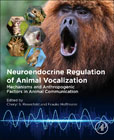
Neuroendocrine Regulation of Animal Vocalization: Mechanisms and Anthropogenic Factors in Animal Communication
Rosenfeld, Cheryl S.
Hoffmann, Frauke
Neuroendocrine Regulation of Animal Vocalization: Mechanisms and Anthropogenic Factors in Animal Communication examines the underpinning neuroendocrine (NE) mechanisms that drive animal communications across taxa. Written by international subject experts, it focuses on the importance of animal communication in survival and reproduction at an individual and species level, and the impact of that increased production and accumulation of endocrine disrupting chemicals (EDCs) can have on disturbing these normal regulatory processes. This book discusses sound production, perception, processing, and response across a range of animals. This includes insects, fish, bats, birds, non-human primates, and infant humans. Each chapter covers the physiology of the animal's perceptive organs, auditory receptors and pathways, analyzing how neuroactive substances, endocrine control, and chemical changes in the environment affects these factors. Neuroendocrine Regulation of Animal Vocalization is a valuable resource for researchers and advanced students seeking first-rate material on the neuroendocrinological effects to animal behavior and communication. The most comprehensive cross-taxa study of its kind, revolutionary in its focus on the impacts of EDCs in the regulatory processes guiding animal communicationDiscusses intra- and inter-sexually selected traitsEmphasizes the importance of acoustic vocalization perception and processing for survivalAnalyzes recent governmental policies and the subsequent effects of EDCs on humans and wildlife INDICE: I. Introduction II. Sound production and perception 1. Sound production and perception in invertebrates 2. Sound production and perception in vertebrates 2.1 Underwater sound production and perception 2.2 Terrestrial sound production III. The Biology and Politics of a Silent Spring 3. Endocrine disruption of vocalizations 4. Governmental actions against this increasing problem in the U.S. 5. Green chemistry as potential alternatives 6. Concluding remarks
- ISBN: 978-0-12-815160-0
- Editorial: Academic Press
- Encuadernacion: Rústica
- Páginas: 416
- Fecha Publicación: 01/08/2020
- Nº Volúmenes: 1
- Idioma: Inglés
